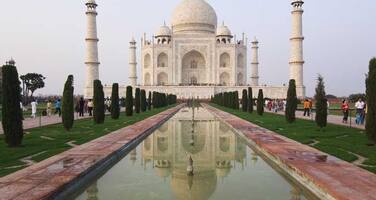Taj Mahal
Factors affecting the property in 1997*
- Air pollution
International Assistance: requests for the property until 1997
Total amount approved : 35,000 USD
| 1994 | Financial contribution to reduce air pollution in Taj ... (Approved) | 20,000 USD |
| 1986 | Consultants to advise the authorities on the ... (Approved) | 15,000 USD |
Missions to the property until 1997**
Information presented to the Bureau of the World Heritage Committee in 1997
A French private enterprise, Rhône Poulenc, will provide US $ 236,735, to fund a three-year research project for the conservation of the Taj Mahal and monuments at Agra Fort and to establish a conservation laboratory in Agra Fort. This will also fund UNESCO participation in the TA-2474 Agreement for the Environmental Improvement and Sustainable Development of the Agra and Mathura Trapezium Programme, funded by the Asian Development Bank.
Action Required
"The Bureau takes note of the information provided by the Secretariat on the extrabudgetary funded support for the conservation and enhancement of the
management of these three sites. It requests the Indian authorities concerned to keep the Secretariat informed on the progress of the research project, the
establishment of the conservation laboratory, and of the TA-2474 Agreement for the Environmental Improvement and Sustainable Development of the
Agra and Mathura Trapezium Programme."
Conservation issues presented to the World Heritage Committee in 1997
Serious air pollution surrounding these sites has led to the deterioration of the white marble, stone inlays and sandstone of the three sites. The Archaeological Survey of India (ASI) and the Government of India have systematically cleaned the surfaces of the stone, replaced deteriorated panels, and taken measures to reduce air pollution by imposing various restrictions on the industries concerned. The planned construction of a new industrial complex near the Taj Mahal was recently prevented. However, a comprehensive assessment of the origin and impact of the environmental pollution is necessary.
A French private enterprise, Rhône Poulenc, will provide US $ 236,735, to fund a three-year research project for the conservation of the Taj Mahal and monuments at Agra Fort and to establish a conservation laboratory in Agra Fort. This will also fund UNESCO participation in the TA-2474 Agreement for the Environmental Improvement and Sustainable Development of the Agra and Mathura Trapezium Programme, funded by the Asian Development Bank.
Summary of the interventions
Decisions adopted by the Committee in 1997
21 COM VII.C.55
Reports on the state of conservation of cultural properties noted by the Committee
VII.55 The Committee noted the decisions of the twenty-first extraordinary session of the Bureau on the following cultural properties as reflected in the report of the Bureau session, Working Documents WHC-97/CONF.208/4B Section III.C.c):
Joya de Ceren Archaeological Site (El Salvador)
Le Canal du Midi (France)
Mont-Saint-Michel and its Bay (France)
Ashanti Traditional Buildings (Ghana)
Maya Site of Copan (Honduras)
Agra Fort, Taj Mahal, Fatehpur Sikri (India)
Quseir Amra (Jordan)
Town of Luang Prabang (Lao People's Democratic Republic)
Pre-Hispanic City of Teotihuacan (Mexico)
Ilha de Mozambique (Mozambique)
Moenjodaro (Pakistan)
Baroque Churches of the Philippines (Philippines)
Old Town of Segovia and its Aqueduct (Spain)
Cultural World Heritage sites in Sri Lanka
Ancient City of Damascus (Syrian Arab Republic)
Historic Areas of Istanbul (Turkey)
Itchan Kala, Historic Centre of Bukhara (Uzbekistan)
Shibam and Zabid (Yemen).
The Bureau may wish to adopt the following text and transmit it to the Committee for noting:
"The Bureau takes note of the information provided by the Secretariat on the extrabudgetary funded support for the conservation and enhancement of the management of these three sites. It requests the Indian authorities concerned to keep the Secretariat informed on the progress of the research project, the establishment of the conservation laboratory, and of the TA-2474 Agreement for the Environmental Improvement and Sustainable Development of the Agra and Mathura Trapezium Programme."
Documents examined by the Committee
21COM (1997)Exports
* :
The threats indicated are listed in alphabetical order; their order does not constitute a classification according to the importance of their impact on the property.
Furthermore, they are presented irrespective of the type of threat faced by the property, i.e. with specific and proven imminent danger (“ascertained danger”) or with threats which could have deleterious effects on the property’s Outstanding Universal Value (“potential danger”).
** : All mission reports are not always available electronically.


